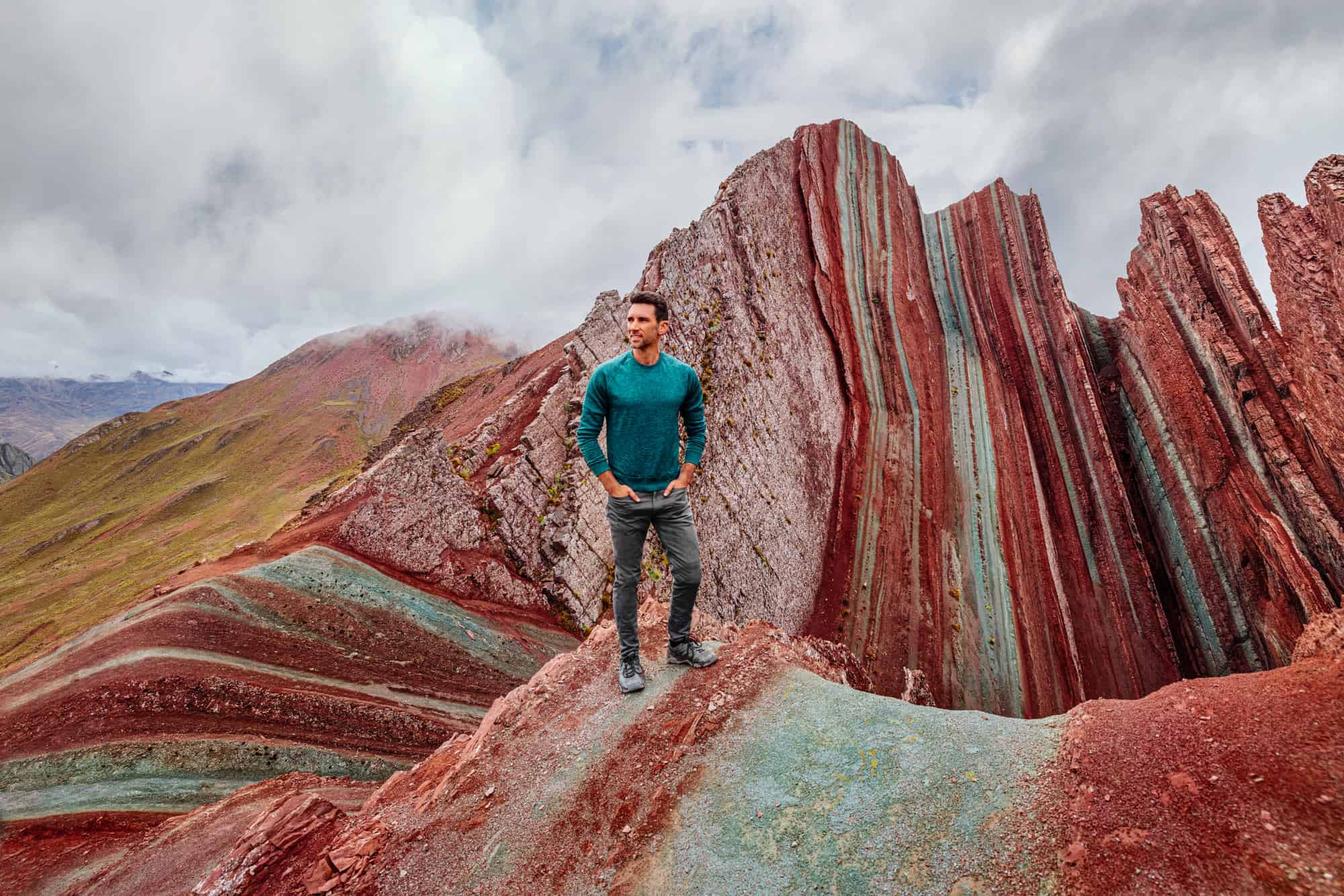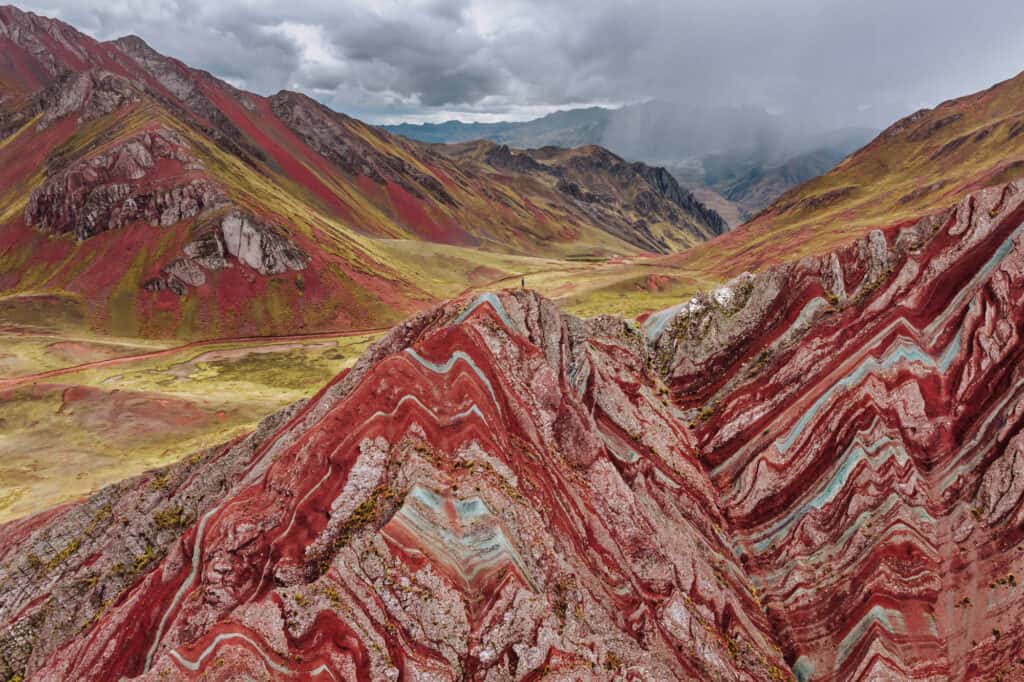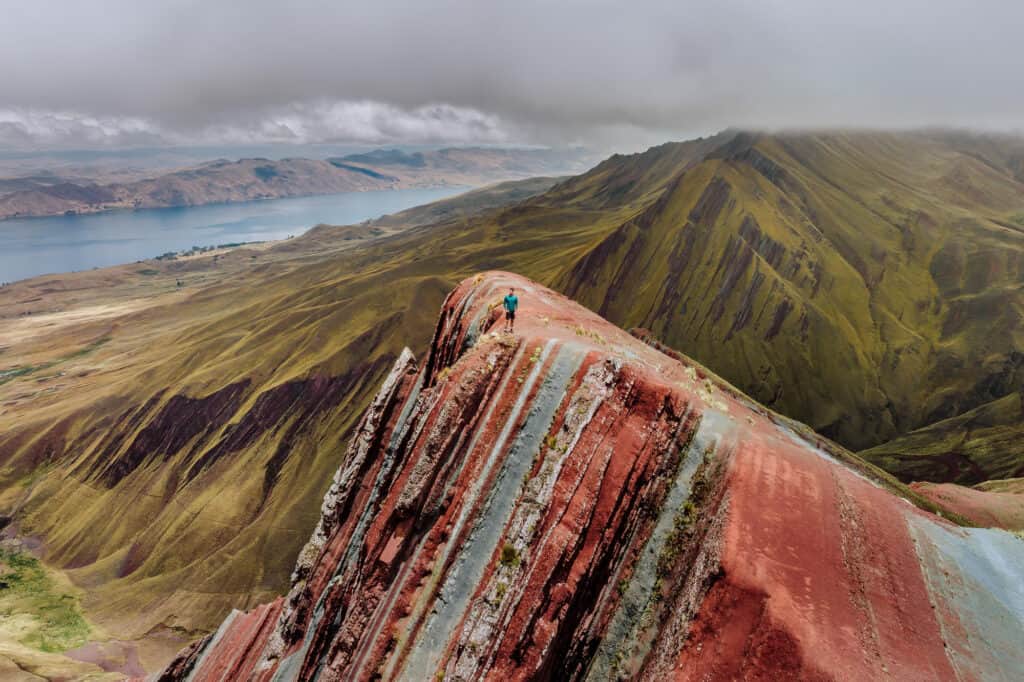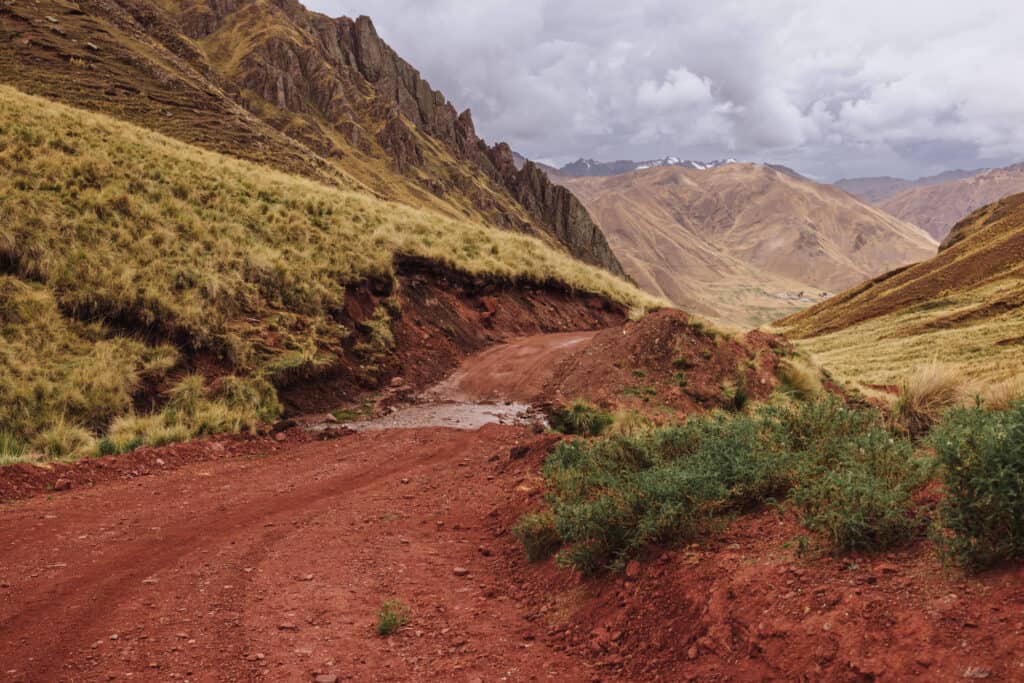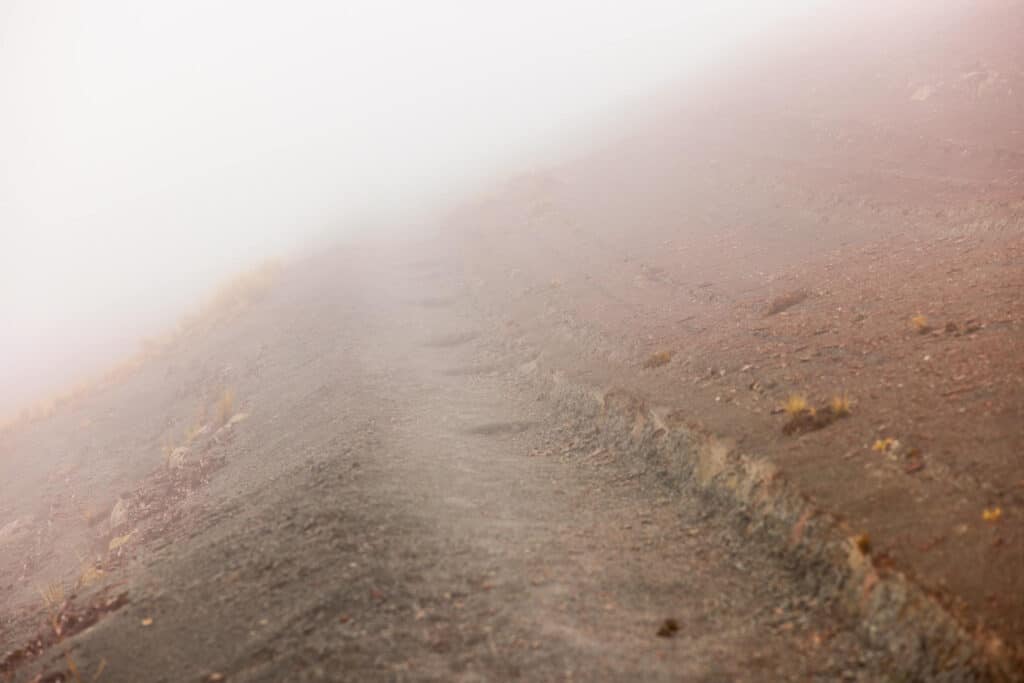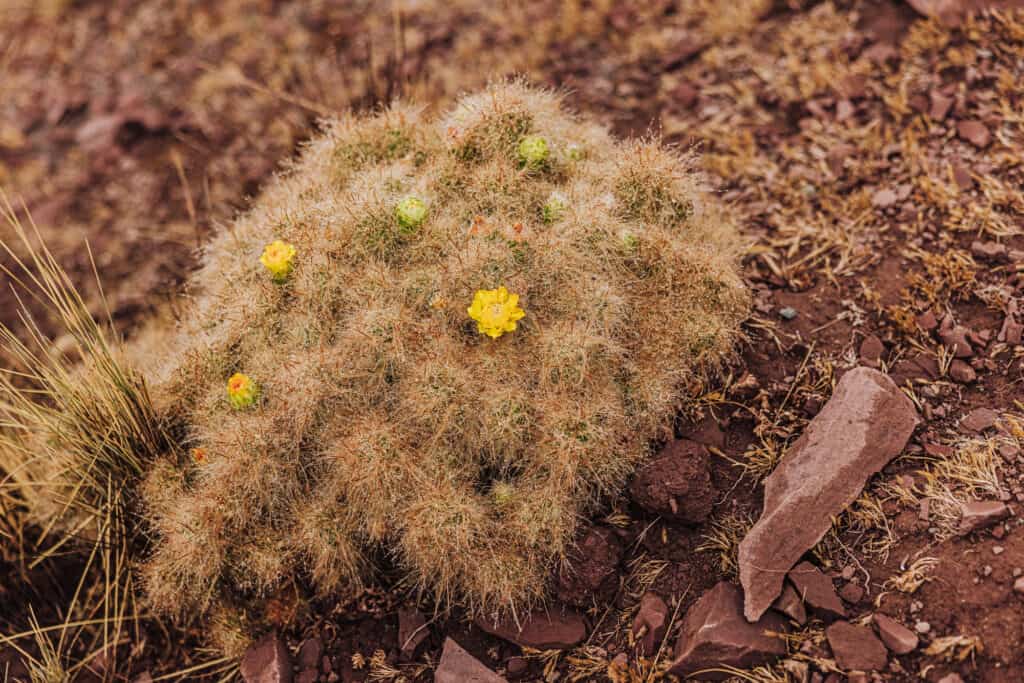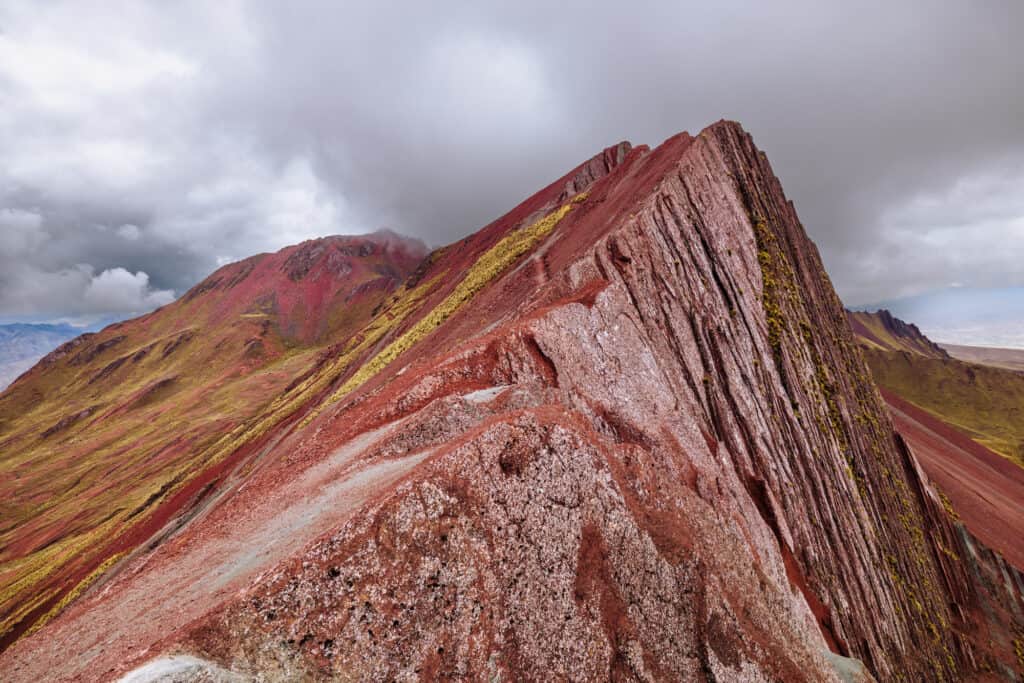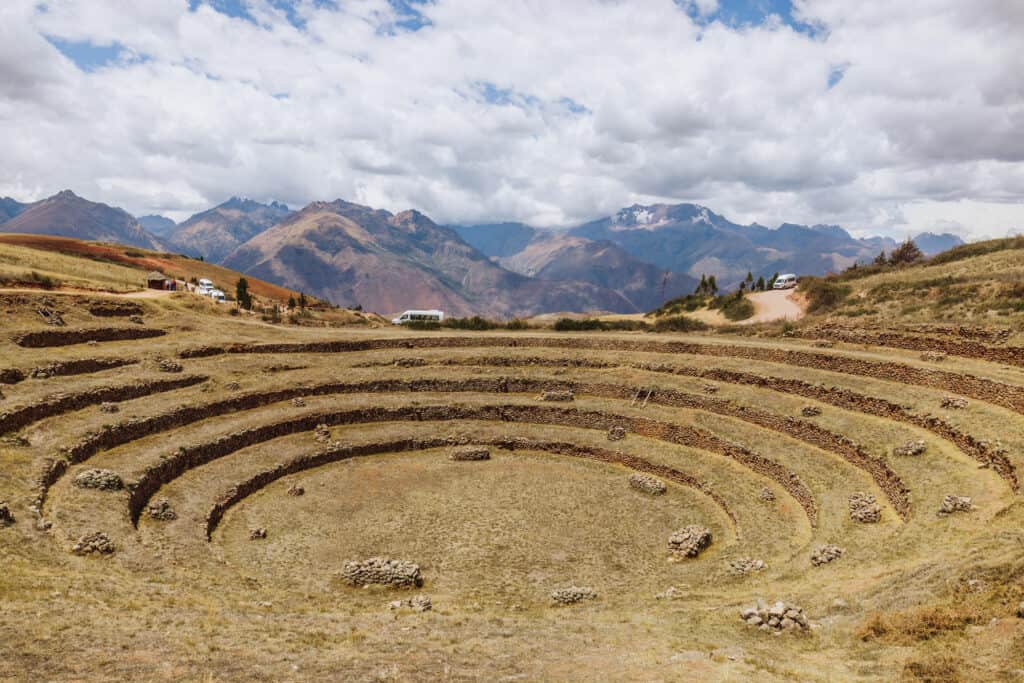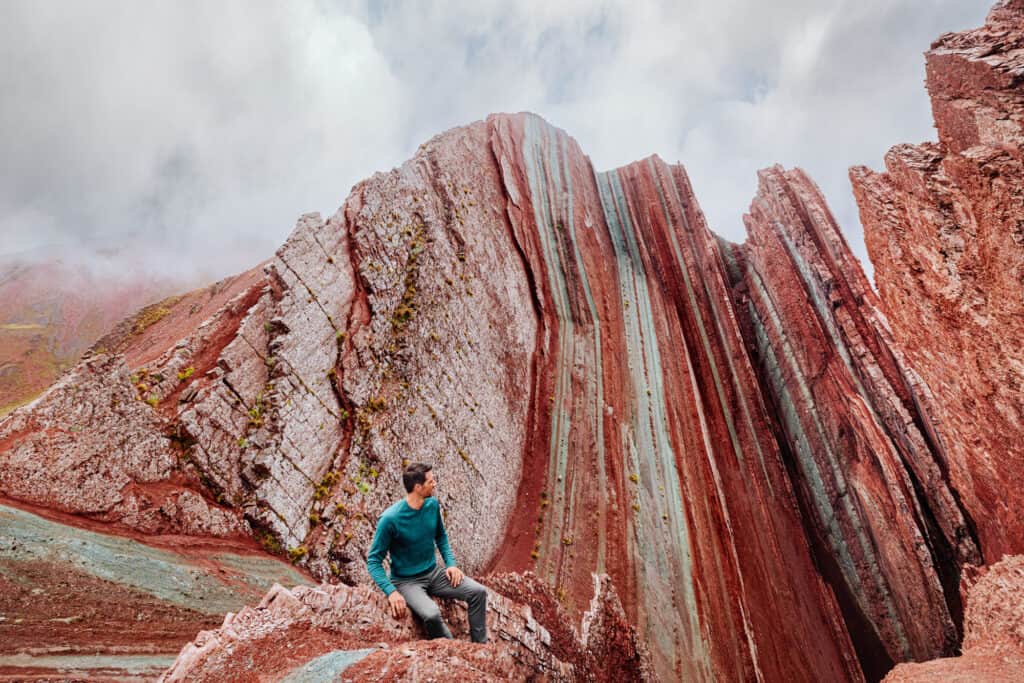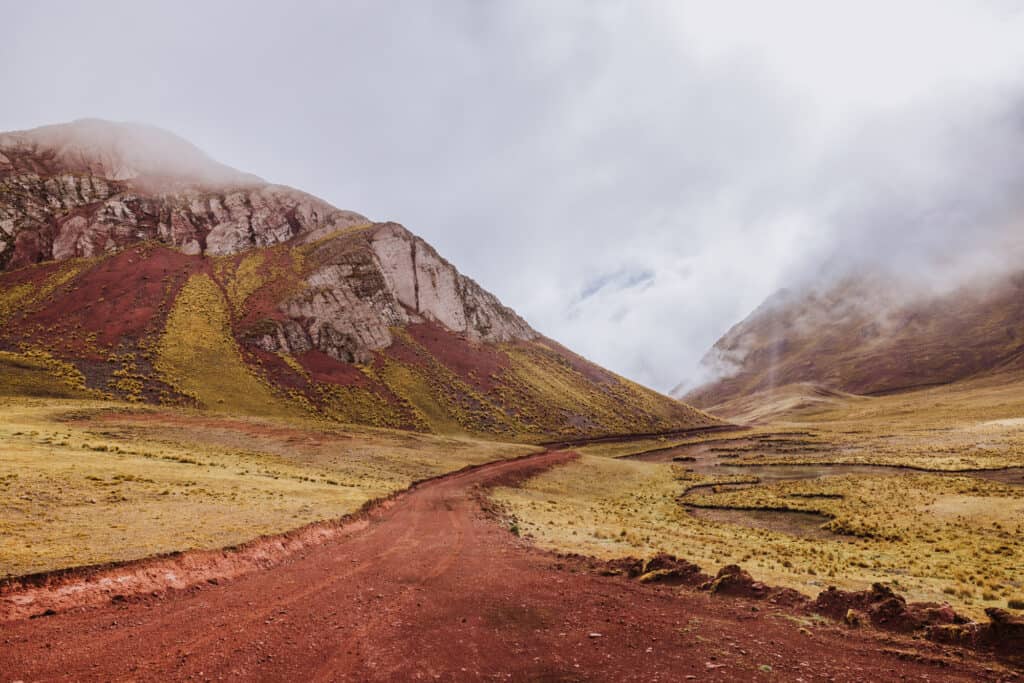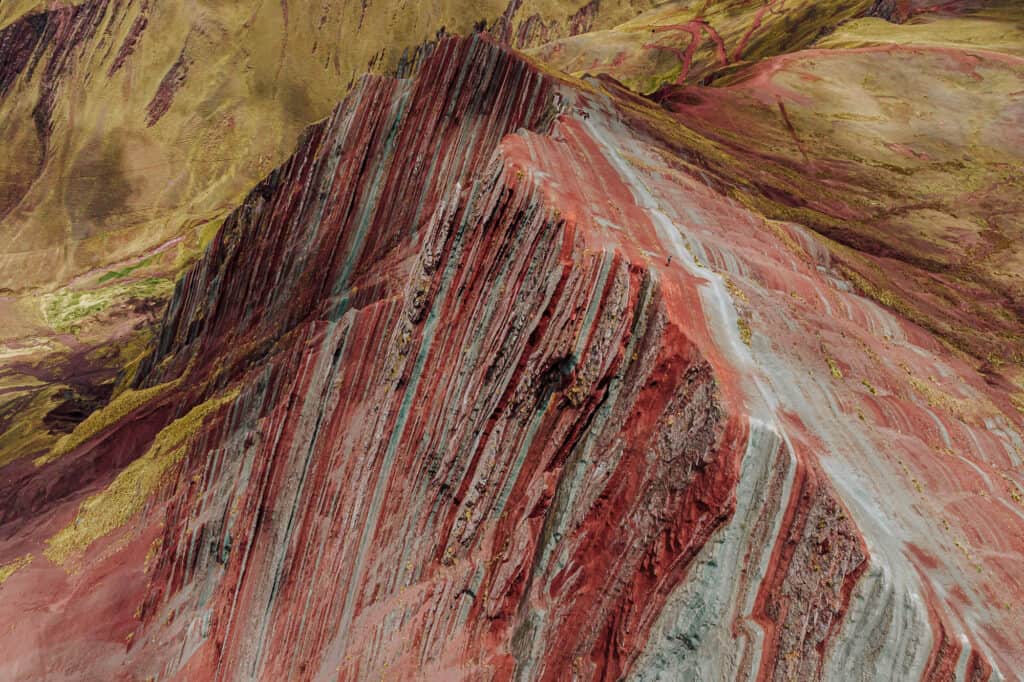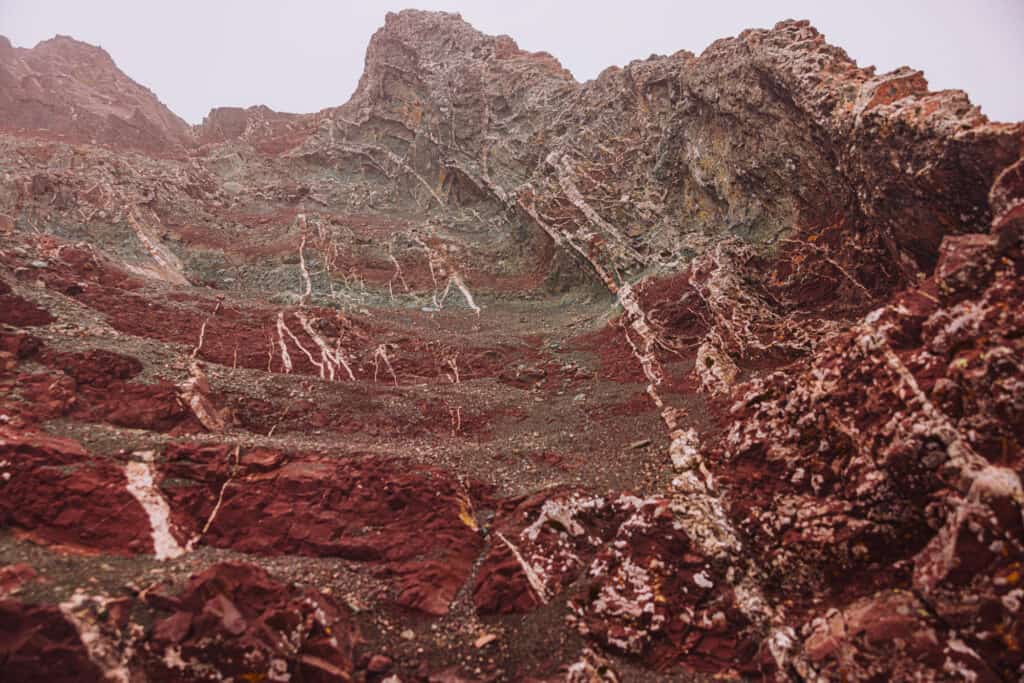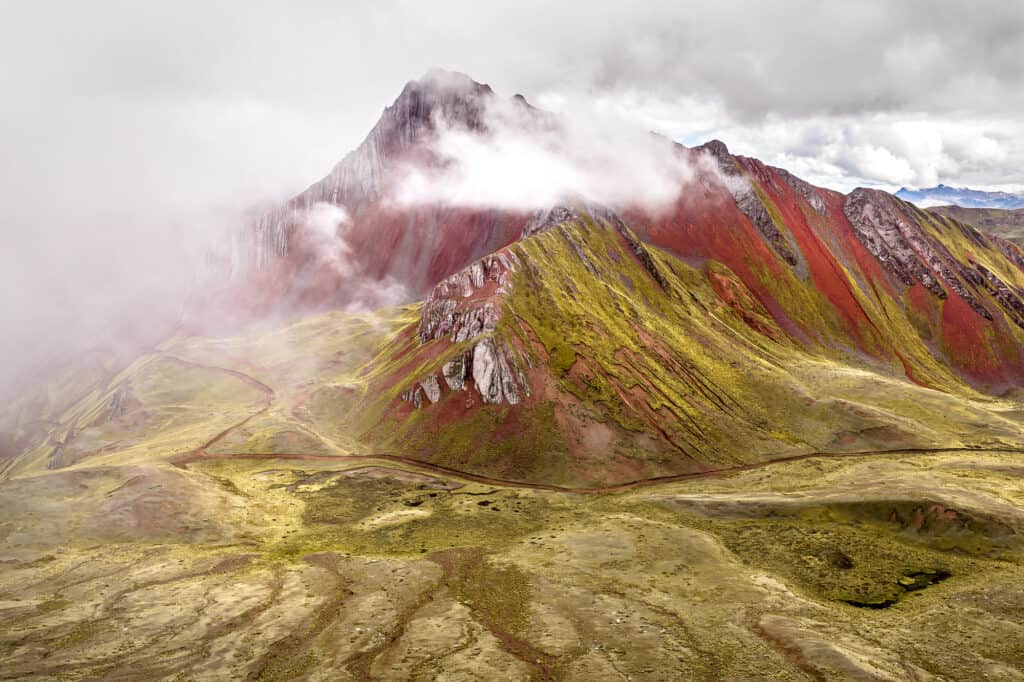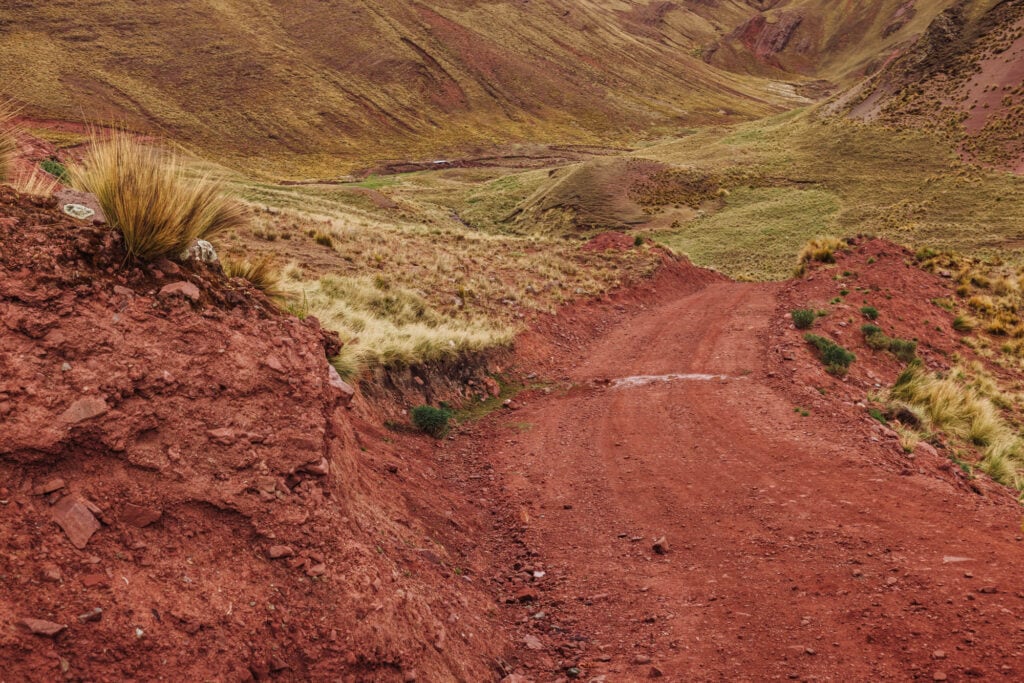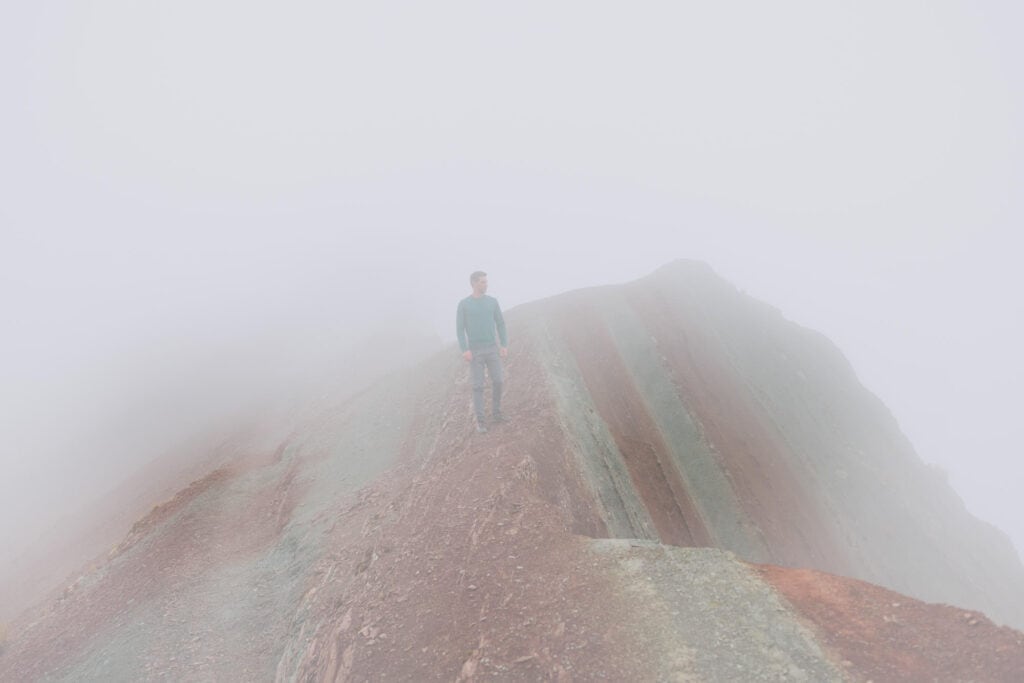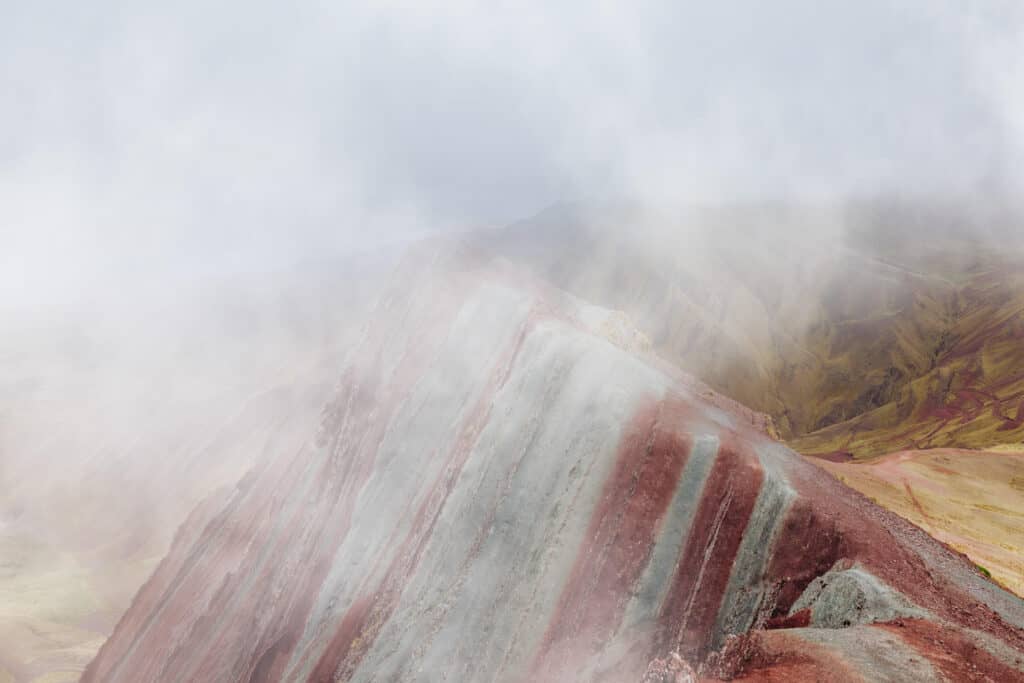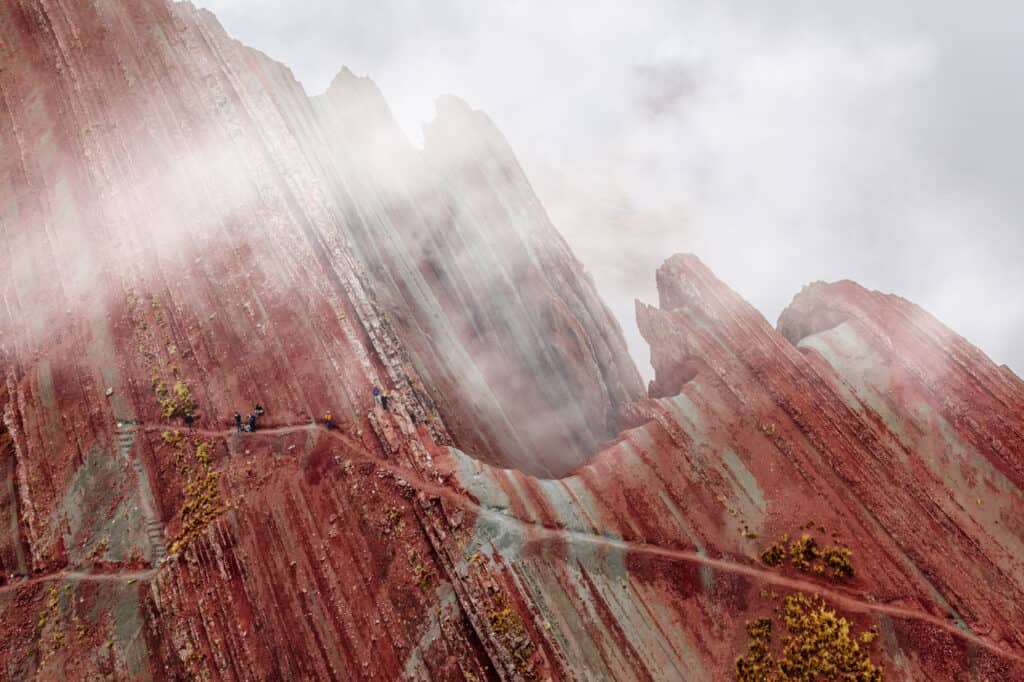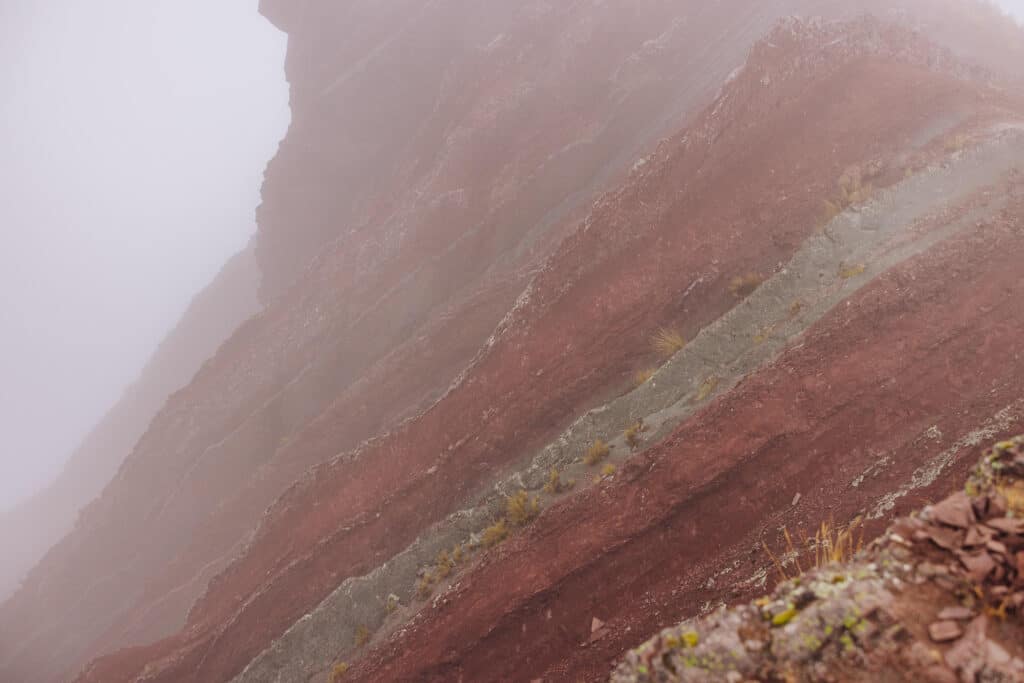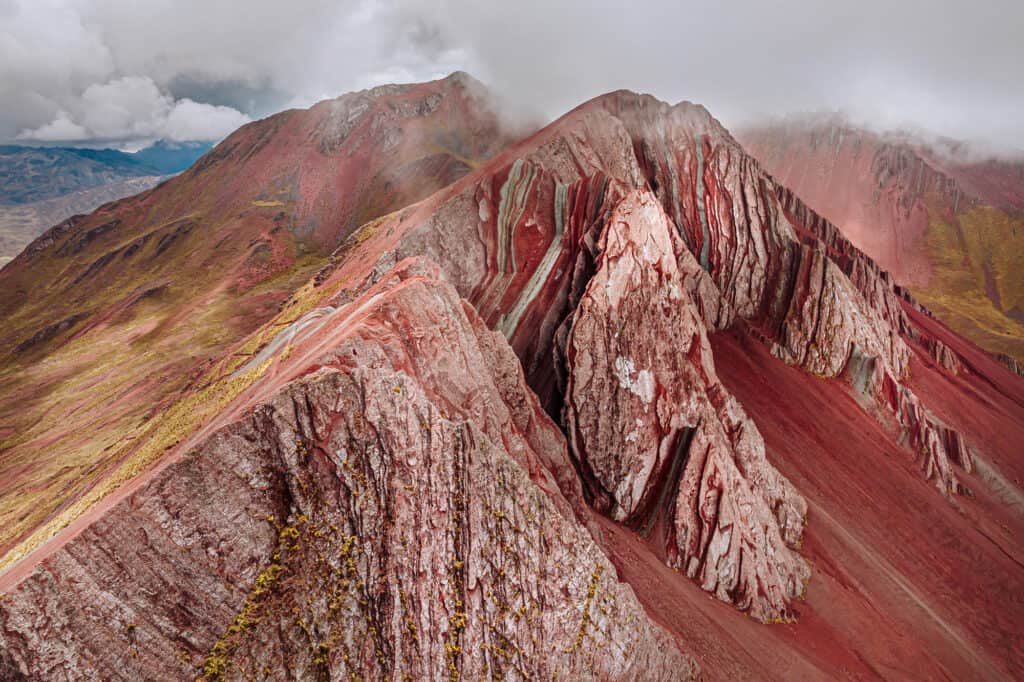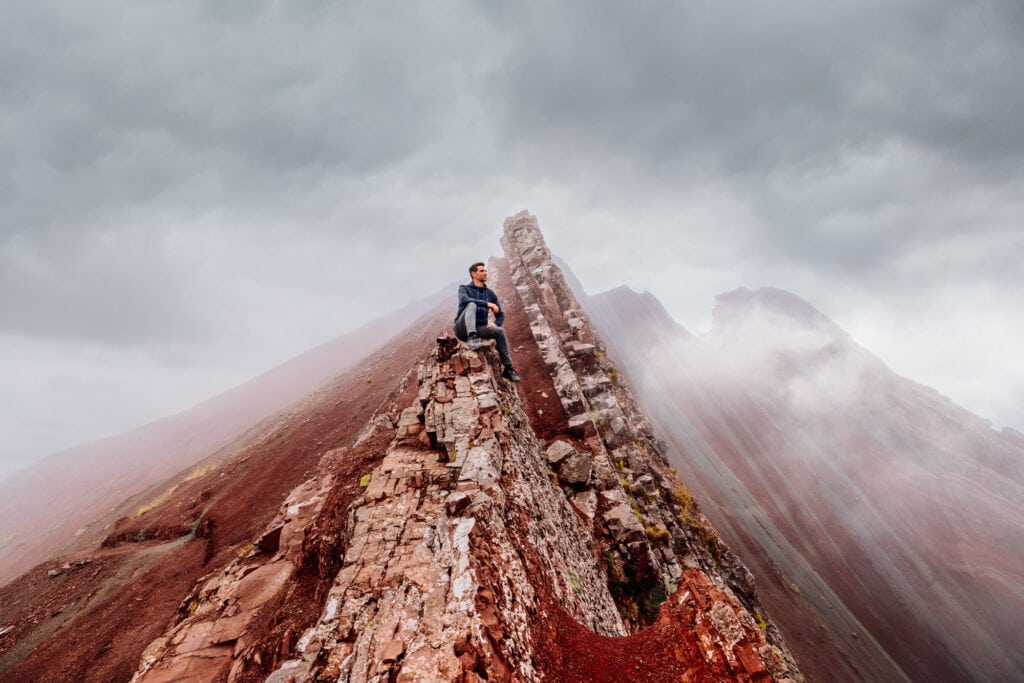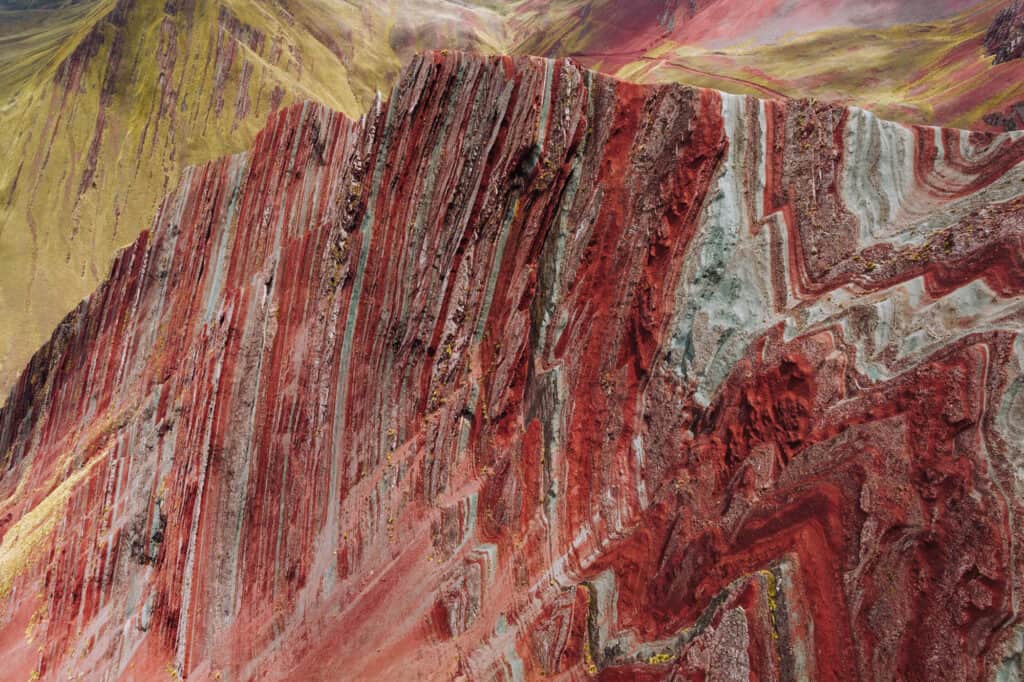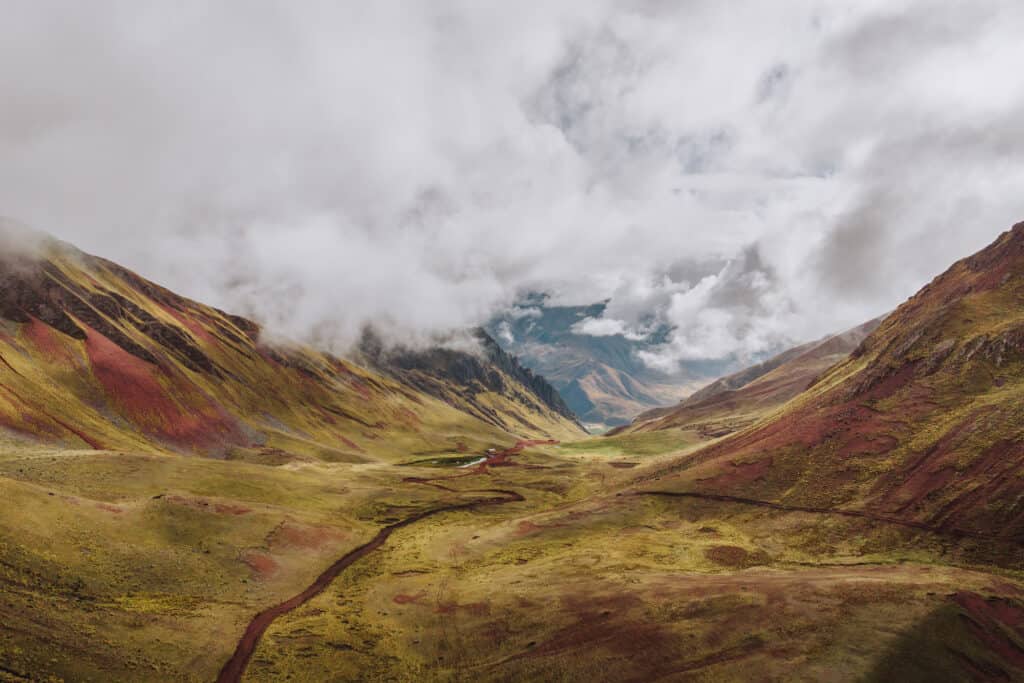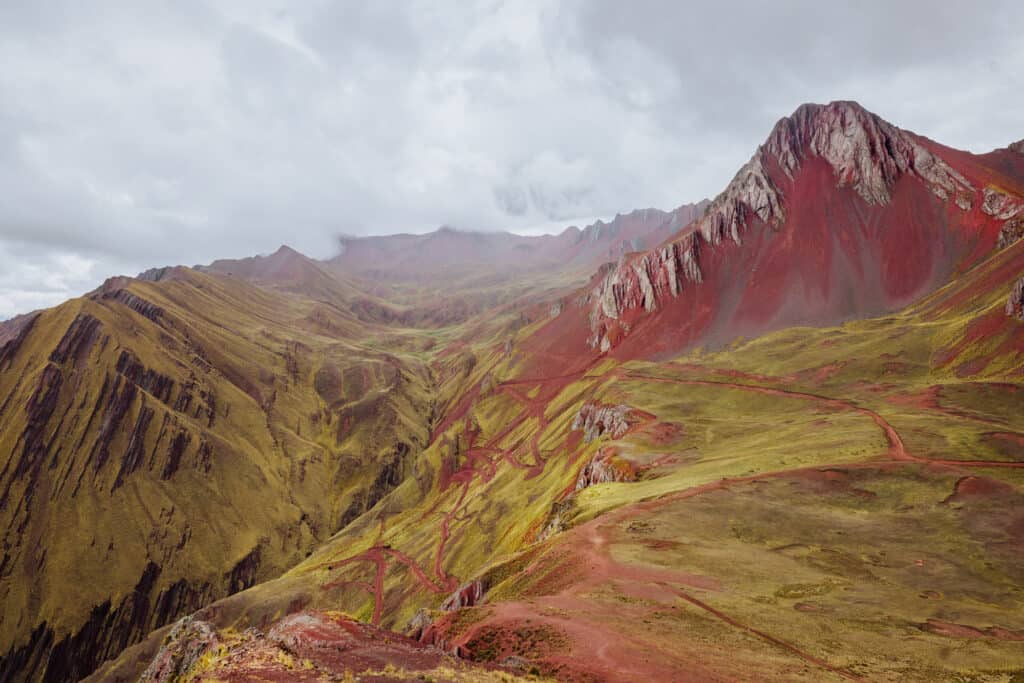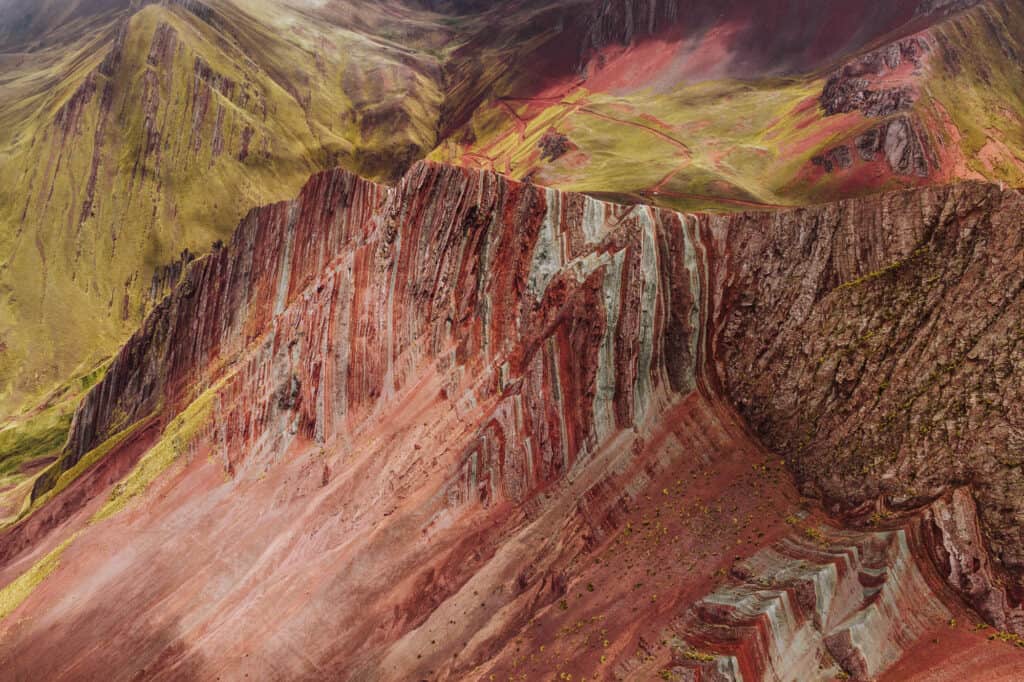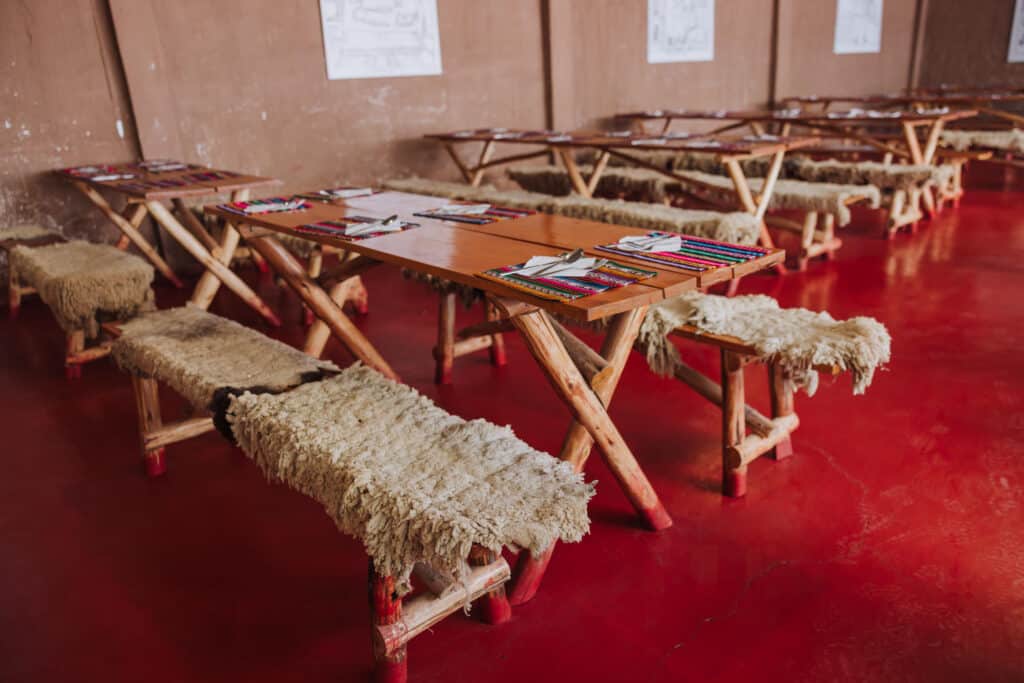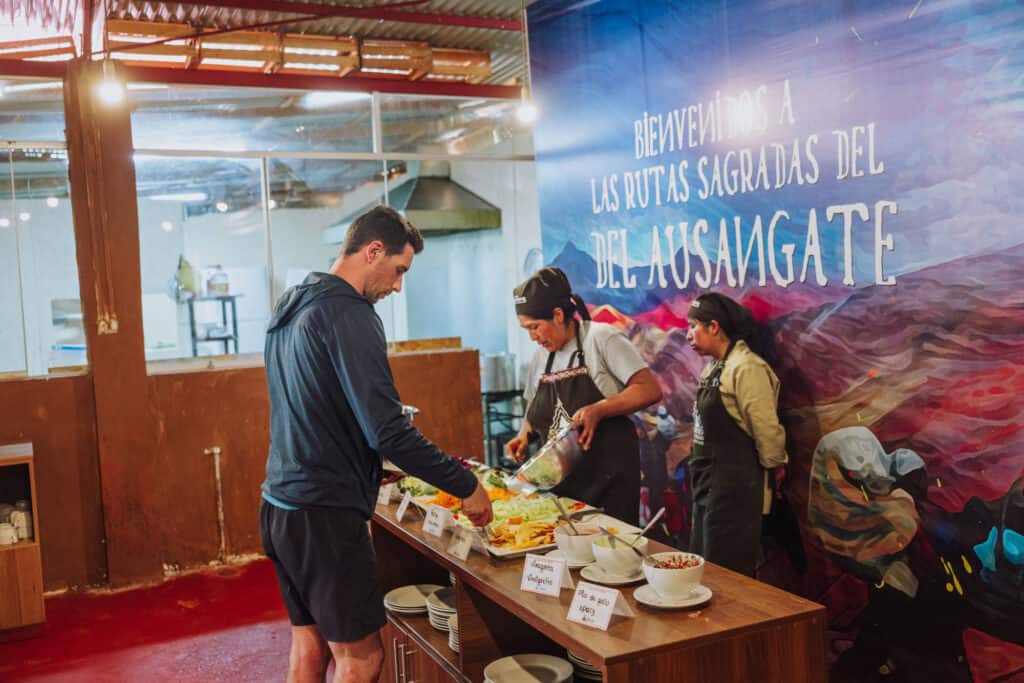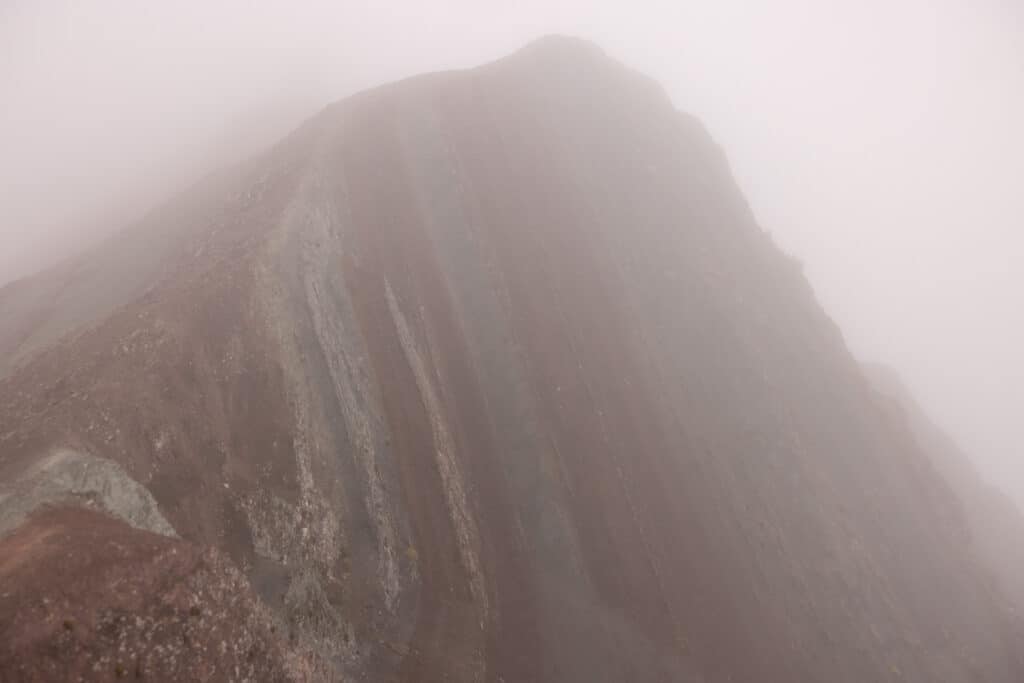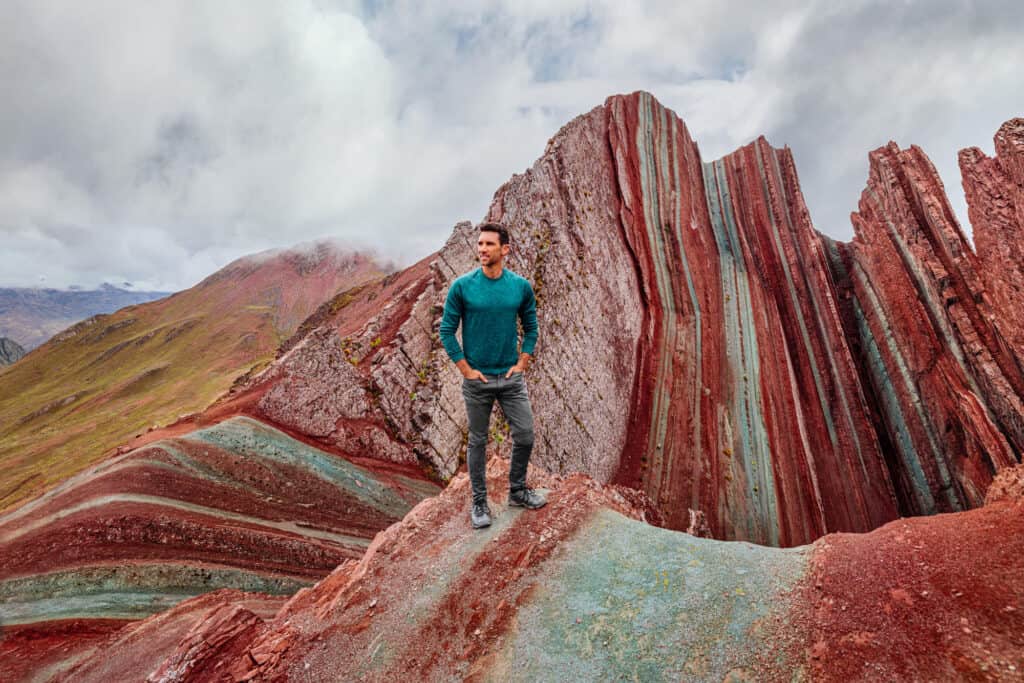Pallay Punchu: Peru’s New Rainbow Mountain
Pallay Punchu, sometimes spelled Pallay Puncho or Poncho, is a mountain becoming more well-known for its striking teal and maroon colors in the rocks.
It’s named after the colorful designs on traditional ponchos worn in South America.
It’s comparable, in some ways, to the famous Rainbow Mountain in the Cusco region. But unlike Rainbow Mountain, where you’re likely to be in a large crowd of people hiking to the top, you’ll likely be one of just a few people on the trail to Pallay Punchu.
The hike isn’t dangerous or overly-challenging, but the payoff is huge! The views are stunning and unique, thanks to the stripes and swirls of the minerals in the rocky peak.
Cusco to Pallay Punchu Tour
I don’t recommend driving yourself around Peru, unless you have a lot of time and patience and experience driving in the region.
The roads aren’t well-marked, and you’ll almost always have to take a narrow dirt road to your destination. In our case, the vehicle literally had to be pushed up the muddy road a few times!
With that said, I give this tour 5-stars.
➡️ Click to Book: Pallay Punchu Tour
The guide and driver were both great. They allowed us to leave earlier than planned (to get there before the sun rose too high) and were very flexible with our schedule.
They also brought blankets and snacks, which made for a very comfortable ride (and lengthy nap along the way)!
Hike Pallay Punchu (Puncho) Mountain
A trip to Pallay Punchu is a full-day adventure.
The tour guides usually pick people up in Cusco around 4:00am or 5:00am.
In our case, we left the hotel at 4:00am, and napped along the 3+ hour drive.
The last part of the ride is up a windy, dirt road.
Streams run across it, so conditions can be rough. (Another reason to take a tour, rather than drive yourself.)
Chances are, your vehicle could be the only one parked in the small lot at the trailhead! There’s really no sign or indication that you’re there. (Another reason to take a tour!)
You could arrive to find dense fog, but most likely the wind will blow it out at some point to reveal the view. Much of the fog comes from the lake (Laguna Langui) on the other side of the mountain.
The trail itself is well-marked. You basically follow the ridgeline up the hill (often through the fog).
I loved the surprising wildflowers and even cacti growing along the trail. I was stunned to see how they could survive in the elements at this elevation!
There are several viewpoints toward the peak. Each has a different rock formation, with mesmerizing stripes of mineral-rich rock.
Pallay Punchu Map & Location
Pallay Punchu can be challenging to find on the map. It’s closest to the small town of Sayapampa.
It’s directly north of a small town called Layo, which sits on the shore of Laguna Langui (Langui Lake).
Directions to Pallay Punchu (Puncho)
The coordinates of the entrance to the dirt road which leads from the highway to Pallay Punchu’s parking lot are: 14°26’02.7″S 71°06’11.2″W
Pallay Punchu Hike Difficulty
The hike from the parking lot is only a mile, but as is the case with so many hikes in Peru (Rainbow Mountain, Lake Humantay, etc.) the elevation is the biggest challenge!
I hike several days a week in Arizona, but the elevation is 1,000 feet above sea level.
So while the steepness of the climb is manageable for almost all hikers, the elevation will get you!
Pallay Punchu (Puncho) Elevation
The peak at Pallay Punchu is about 13,000 feet above sea level. It definitely helps to spend a couple of days in Cusco before setting out on this hike, just to allow your body to acclimate to the altitude!
Here’s how Pallay Punchu’s elevation compares to other famous sites in the Cusco Region:
- Cusco City: Cusco itself is situated at a high altitude of around 11,000 feet above sea level.
- Machu Picchu: Machu Picchu is at an altitude of approximately 8,000 feet above sea level.
- Sacred Valley of the Incas: The Sacred Valley, which includes towns like Pisac and Ollantaytambo, ranges in altitude, but most sites are between 9,000 and 10,000 feet above sea level.
- Rainbow Mountain (Vinicunca): Rainbow Mountain’s summit reaches over 16,000 feet.
- Saksaywaman: This ancient Inca fortress overlooking Cusco sits 12,000 feet above sea level.
- Moray: The archaeological site of Moray, known for its circular agricultural terraces, is at an altitude of approximately 11,400 feet (pictured below).
Pallay Punchu vs. Rainbow Mountain
Pallay Punchu earned the nickname “the new Rainbow Mountain” as more people started hiking it during and after the pandemic.
Rainbow Mountain, also known as Vinicunca or Montaña de Siete Colores (Mountain of Seven Colors), is now one of the most popular tourist destinations in Peru. It attracts travelers drawn by the unique geography and geology.
If you have time, I’d say it’s worth visiting both sites, since they’re different experiences.
If you only have time for one day trip, maybe this information will help you decide which to choose.
Pallay Punchu vs. Rainbow Mountain: Location
Both Pallay Punchu and Rainbow Mountain are in the Cusco Region of Peru, and both are about 3 to 3.5 hours away from the city of Cusco.
The drive time is affected by weather and road conditions.
Pallay Punchu vs. Rainbow Mountain: Altitude / Elevation
Rainbow Mountain is at a high altitude, with its summit reaching 16,400 feet above sea level.
Pallay Punchu is slightly lower, at around 13,000 feet.
Pallay Punchu vs. Rainbow Mountain: Geology
Rainbow Mountain is known for its vibrant and distinct layers of mineral-rich sediment that create a breathtaking spectrum of colors, ranging from red and pink to green and turquoise. The colors are a result of various minerals, including iron, sulfur, and copper, present in the soil.
It’s worth noting: visitors are often surprised to find the colors more muted and natural, compared to the way they appear in advertisements and on social media.
Pallay Punchu has stripes of copper (the teal color) and maroon (from iron). The peak also has veins of quartz running through it.
Pallay Punchu vs. Rainbow Mountain: Accessibility
Having been to both, I’d definitely recommend an early morning tour to either (rather than trying to drive yourself)
Pallay Punchu vs. Rainbow Mountain: Crowds
You’ll encounter hundreds of other travelers (maybe more than a thousand) on any given day at Rainbow Mountain. I was there in January, and it was packed. I can’t imagine what it’s like at the peak season!
The increasing popularity of Rainbow Mountain has raised concerns about environmental sustainability and the impact of tourism on the fragile ecosystem in the region. There are discussions about limiting visitor numbers to better-preserve the site.
As I mentioned, you’ll likely only find another car or two in the lot at Pallay Punchu.
Pallay Punchu (Puncho) Geology & Stripes
The vibrant stripes at Pallay Punchu are the result of alternating copper and iron in the rock.
The teal or turquoise color in the copper is the result of oxidation.
The iron turns a rusty red color as it oxidizes, contrasting beautifully with the teal copper.
You’ll notice, especially as you reach the peak, that the mountain has veins of quartz running through it, too.
From the trail, looking across the valley you’ll also see several other colorful and striped mountains from the mineral-rich rocks in the region.
The Weather at Pallay Punchu
There’s no real way to check the weather forecast before a trip to Pallay Punchu, though you can check the radar on an app if you have one that shows conditions in South America.
The important thing to remember is: prepare for all kinds of weather! Dress in layers, with a raincoat, a hat and gloves. It’s better to be over-prepared!
The weather at the mountain will likely be different from what it’s like in the city of Cusco.
Temperatures could start off near freezing, then warm as the sun rises to the point that you’re sweating.
On Our Visit
We went in October, and found mixed conditions. On the day prior to our visit, it rained, creating muddy conditions on the road to Pallay Punchu.
We arrived at 7:00am, and the fog was so thick we couldn’t even see the mountain from the parking lot! We waited a bit, then hiked up in the fog, hoping it would lift.
Two hours later, around 9:00am, most of the fog lifted, revealing the stunning view.
The following two photos are from the same spot, showing the fog once it started to lift, and then after it was gone. You’ll also see the lake in the background (the source of the fog!).
Over the next few hours, clouds and fog would drift in and out with the wind.
Temperatures were around 40 degrees when we arrived, but climbed to where it was warm enough for shorts by late morning.
Weather Conditions by the Season
While conditions are unpredictable, here is what you can generally expect, by the season:
Dry Season (May to September):
- This is considered the best time to visit the Andes. The weather is generally dry and clear.
- Daytime temperatures can range from cool to mild, but nights can be cold, and temperatures may even drop below freezing overnight.
Rainy Season (November to March):
- This period brings higher chances of precipitation, including rain and snow.
- Days can be cloudy or foggy, and visibility may be reduced, impacting the panoramic views of the mountains and valley.
- It’s often windy in December, January, and February.
- The trail and dirt road can be more challenging due to wet and muddy conditions.
Transitional Months (April and October):
- Weather during these transitional months can be especially unpredictable.
- Many days will be beautiful and sunny, but there’s always a chance for rain showers (and fog).
Regardless of the season, it’s crucial to be aware of the high-altitude environment, and acclimate your body before any strenuous hikes.
What to Bring to Pallay Punchu
The tour guide will come well-equipped, but you should bring plenty of food and clothing on your trip!
Clothing
As I mentioned above, bring layers of clothing to peel off as the day warms up. You’ll likely be chilly on the drive, and as you start the hike. I’d definitely recommend a hat and gloves, which you can shed easily as you climb.
A lot of people bring hiking poles, too. Frankly, I wish I had them for the steeper parts on the hike down!
Bring a rain shell or parka, just in case it starts to rain.
Footwear
You don’t need to go overboard with anything special in terms of hiking boots.
Whatever you’d wear to Machu Picchu, you can wear to Pallay Punchu. Just make sure they have decent tread on the bottom.
Food
Many of the tours will include a breakfast stop and a lunch spot (before and after the hike). Still, it’s good to bring a bunch of snacks to eat during the 6+ hours you’ll be in the car.
Bring extra water to leave in the car to drink on your drive back to Cusco.
Pallay Punchu Photos
We found so many beautiful formations and patterns in the rock, I wanted to post a few more for you to check out!
Pallay Punchu Drone
Drones are allowed to fly at Pallay Punchu, and chances are: you’ll be the only one up there, so you won’t have to worry about a mid-air collision!
FAQs on Pallay Punchu (Puncho)
Let’s tackle a few frequently-asked-questions about Pallay Punchu, most of which were answered above.
Can you do a one-day tour of Pallay Punchu?
Yes, this is the best option for a tour from Cusco. You’ll leave before dawn on a 3-hour (roughly) drive, stop for breakfast, hike the mountain for a few hours, and head back to Cusco in the afternoon.
Is a Pallay Punchu tour good for kids?
If your children are also going to Machu Picchu and other sites around Peru, they’ll enjoy Pallay Punchu, too.
What’s the elevation of Pallay Punchu?
The elevation is around 13,000 feet above sea level at the peak of Pallay Punchu.
How long is the hike on the Pallay Punchu tour?
The climb is about one mile, from the small parking lot to the viewpoints at the peak. With the elevation slowing us down, it took about 40 minutes to hike up.
Can I go to Pallay Punchu independently, without a tour?
In theory, yes, you can visit Pallay Punchu on your own. However, unless you’re familiar with the roads in Peru and directions, it’s easier and safer to go with an experienced driver or guide.
The route isn’t marked well, and it takes you through small villages and up a windy, dirt road (often covered in mud).
Are there restaurants near Pallay Punchu?
If you go on a tour, the driver will take you to breakfast on the way, and then a lunch spot on the way home. It’s a popular spot in a small town, which hosts a lot of tourists during the day.
Why is Pallay Punchu called the “new” Rainbow Mountain?
During the pandemic, when travel and tourism were greatly restricted in Peru, more locals began discovering and hiking Pallay Punchu. As they posted their photos online, they gained traction and some more social media fame. It’s a great alternative to hiking with the big crowds at Rainbow Mountain.
Is there an entry fee to hike Pallay Punchu?
At this point, there are no fees for this mountain (unlike most spots in Peru) but that could change as it grows in popularity.
Wrap: Is Pallay Punchu Worth It?
A trip to hike Pallay Punchu is a full day, and it’s worth it, even if you only have a few days in the Cusco region.
It’s a unique spot, relatively undiscovered by the hoards of tourists.
Peru is full of natural beauty and stunning views. What sets Pallay Punchu apart is: you get all of that *without the crowds that flock to Rainbow Mountain, Machu Picchu, and Humantay Lake!
If it’s foggy, be patient, wait a while, and hope for the best! It’ll be worth it!
Check out our other posts on the Cusco region!
🇵🇪 Aguas Calientes: Machu Picchu Pueblo
🇵🇪 Cusco to Machu Picchu: Tours, Trains, & More
🇵🇪 The Best Time to Visit Machu Picchu
🇵🇪 Moray
